 Backend Development
Backend Development
 Python Tutorial
Python Tutorial
 Detailed explanation of the addition, deletion, modification and query operations of mysql in python using pymysql (comprehensive)
Detailed explanation of the addition, deletion, modification and query operations of mysql in python using pymysql (comprehensive)
Detailed explanation of the addition, deletion, modification and query operations of mysql in python using pymysql (comprehensive)
This article mainly introduces the use of pymysql to add, delete, modify and query mysql in python. It uses pymysql to query, delete, add and modify the database. It has certain reference value. Those who are interested can learn more.
This time we will use pymysql to perform all operations of adding, deleting, modifying and checking MySQL, which is equivalent to a summary of the previous five times:
Check the database first:
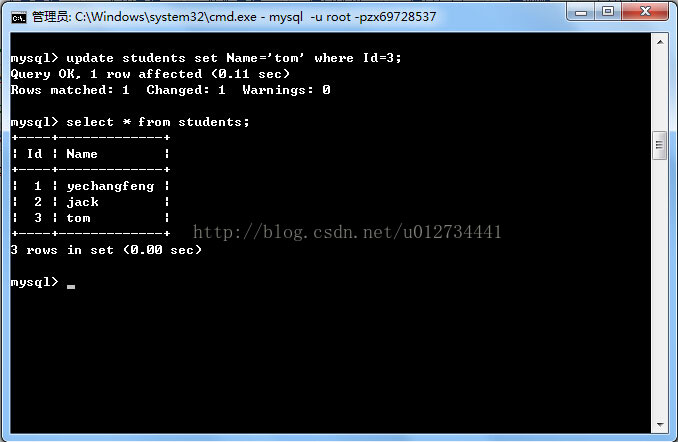
Now write the source code to add, delete, modify and check. The source code is:
#!/usr/bin/python
#coding:gbk
import pymysql
from builtins import int
#将MysqlHelper的几个函数写出来
def connDB(): #连接数据库
conn=pymysql.connect(host="localhost",user="root",passwd="zx69728537",db="student");
cur=conn.cursor();
return (conn,cur);
def exeUpdate(conn,cur,sql): #更新或插入操作
sta=cur.execute(sql);
conn.commit();
return (sta);
def exeDelete(conn,cur,IDs): #删除操作
sta=0;
for eachID in IDs.split(' '):
sta+=cur.execute("delete from students where Id=%d"%(int(eachID)));
conn.commit();
return (sta);
def exeQuery(cur,sql): #查找操作
cur.execute(sql);
return (cur);
def connClose(conn,cur): #关闭连接,释放资源
cur.close();
conn.close();
result=True;
print("请选择以上四个操作:1、修改记录,2、增加记录,3、查询记录,4、删除记录.(按q为退出)");
conn,cur=connDB();
number=input();
while(result):
if(number=='q'):
print("结束操作");
break;
elif(int(number)==1):
sql=input("请输入更新语句:");
try:
exeUpdate(conn, cur, sql);
print("更新成功");
except Exception:
print("更新失败");
raise;
elif(int(number)==2):
sql=input("请输入新增语句:");
try:
exeUpdate(conn, cur, sql);
print("新增成功");
except Exception:
print("新增失败");
raise;
elif(int(number)==3):
sql=input("请输入查询语句:");
try:
cur=exeQuery(cur, sql);
for item in cur:
print("Id="+str(item[0])+" name="+item[1]);
except Exception:
print("查询出错");
raise;
elif(int(number)==4):
Ids=input("请输入Id,并用空格隔开");
try:
exeDelete(conn, cur, Ids);
print("删除成功");
except Exception:
print("删除失败");
raise;
else:
print("非法输入,将结束操作!");
result=False;
break;
print("请选择以上四个操作:1、修改记录,2、增加记录,3、查询记录,4、删除记录.(按q为退出)");
number=input("请选择操作");Now run the program to observe:

Now query the database:
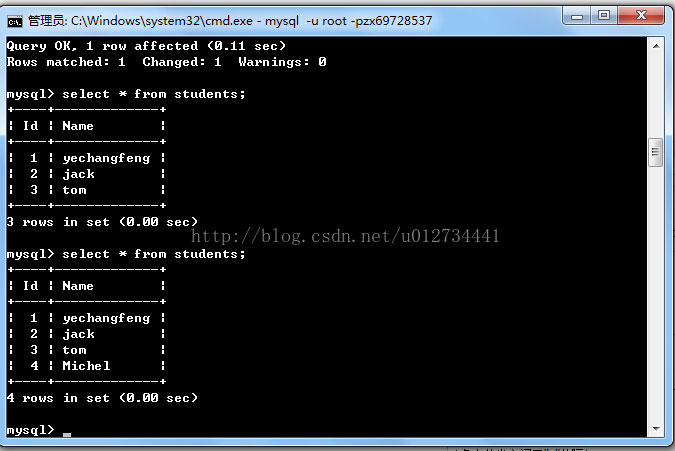
You can see that a new piece of data has been added to the database. Now update the data:
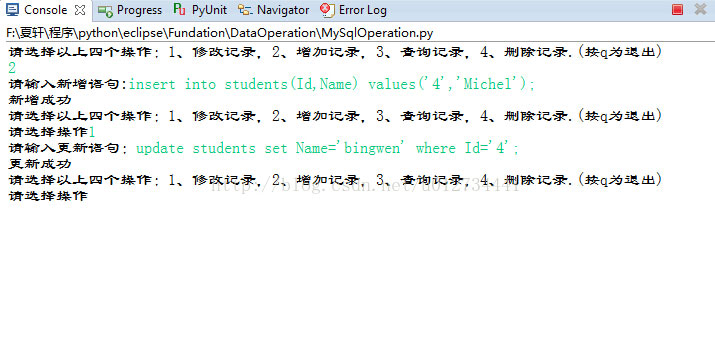
Now we are not querying the database, we are querying directly in the program, as shown in the figure:
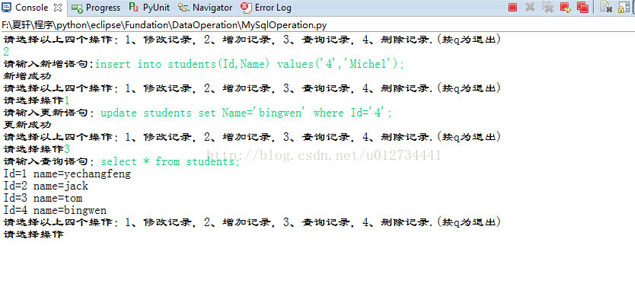
You can see The Name of the fourth data has been updated to bingwen. Now perform the deletion operation to delete the fourth record, as shown in the figure:
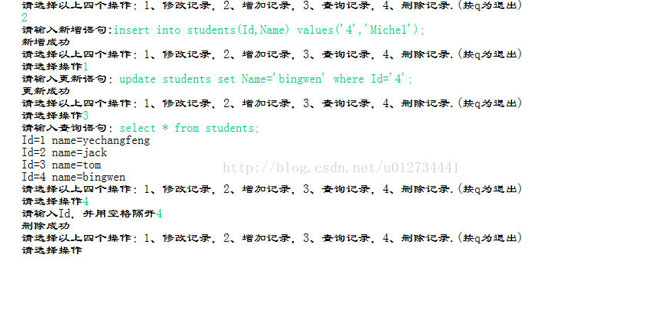
Now we query in the database whether The data is deleted, as shown in the figure:
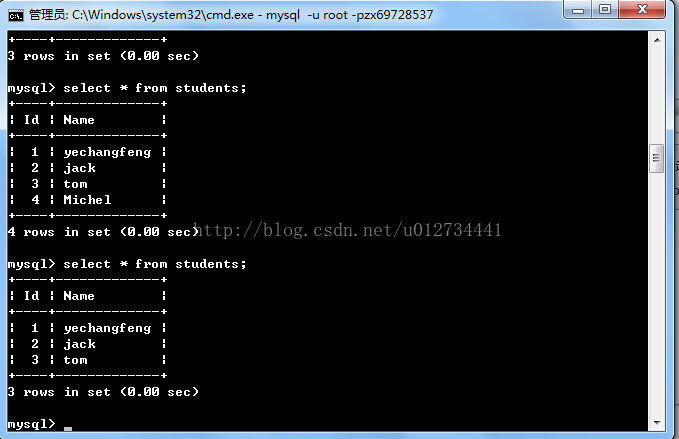
You can see that the deletion operation has been successfully performed. Now exit the current program, as shown in the figure:
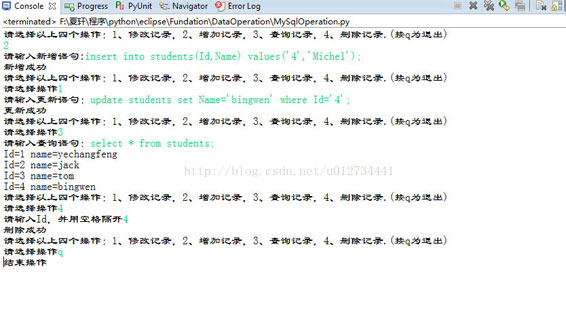
In this way, the addition, deletion, modification and query operations of pymysql on the mysql database are completed.
The above is the entire content of this article. I hope it will be helpful to everyone's learning. I also hope that everyone will support the PHP Chinese website.
For more detailed explanations of using pymysql to add, delete, modify and query mysql in python (comprehensive), please pay attention to the PHP Chinese website for related articles!

Hot AI Tools

Undresser.AI Undress
AI-powered app for creating realistic nude photos

AI Clothes Remover
Online AI tool for removing clothes from photos.

Undress AI Tool
Undress images for free

Clothoff.io
AI clothes remover

Video Face Swap
Swap faces in any video effortlessly with our completely free AI face swap tool!

Hot Article

Hot Tools

Notepad++7.3.1
Easy-to-use and free code editor

SublimeText3 Chinese version
Chinese version, very easy to use

Zend Studio 13.0.1
Powerful PHP integrated development environment

Dreamweaver CS6
Visual web development tools

SublimeText3 Mac version
God-level code editing software (SublimeText3)

Hot Topics
 1655
1655
 14
14
 1413
1413
 52
52
 1306
1306
 25
25
 1252
1252
 29
29
 1226
1226
 24
24
 Python vs. C : Applications and Use Cases Compared
Apr 12, 2025 am 12:01 AM
Python vs. C : Applications and Use Cases Compared
Apr 12, 2025 am 12:01 AM
Python is suitable for data science, web development and automation tasks, while C is suitable for system programming, game development and embedded systems. Python is known for its simplicity and powerful ecosystem, while C is known for its high performance and underlying control capabilities.
 Python: Games, GUIs, and More
Apr 13, 2025 am 12:14 AM
Python: Games, GUIs, and More
Apr 13, 2025 am 12:14 AM
Python excels in gaming and GUI development. 1) Game development uses Pygame, providing drawing, audio and other functions, which are suitable for creating 2D games. 2) GUI development can choose Tkinter or PyQt. Tkinter is simple and easy to use, PyQt has rich functions and is suitable for professional development.
 How Much Python Can You Learn in 2 Hours?
Apr 09, 2025 pm 04:33 PM
How Much Python Can You Learn in 2 Hours?
Apr 09, 2025 pm 04:33 PM
You can learn the basics of Python within two hours. 1. Learn variables and data types, 2. Master control structures such as if statements and loops, 3. Understand the definition and use of functions. These will help you start writing simple Python programs.
 The 2-Hour Python Plan: A Realistic Approach
Apr 11, 2025 am 12:04 AM
The 2-Hour Python Plan: A Realistic Approach
Apr 11, 2025 am 12:04 AM
You can learn basic programming concepts and skills of Python within 2 hours. 1. Learn variables and data types, 2. Master control flow (conditional statements and loops), 3. Understand the definition and use of functions, 4. Quickly get started with Python programming through simple examples and code snippets.
 Python vs. C : Learning Curves and Ease of Use
Apr 19, 2025 am 12:20 AM
Python vs. C : Learning Curves and Ease of Use
Apr 19, 2025 am 12:20 AM
Python is easier to learn and use, while C is more powerful but complex. 1. Python syntax is concise and suitable for beginners. Dynamic typing and automatic memory management make it easy to use, but may cause runtime errors. 2.C provides low-level control and advanced features, suitable for high-performance applications, but has a high learning threshold and requires manual memory and type safety management.
 Python and Time: Making the Most of Your Study Time
Apr 14, 2025 am 12:02 AM
Python and Time: Making the Most of Your Study Time
Apr 14, 2025 am 12:02 AM
To maximize the efficiency of learning Python in a limited time, you can use Python's datetime, time, and schedule modules. 1. The datetime module is used to record and plan learning time. 2. The time module helps to set study and rest time. 3. The schedule module automatically arranges weekly learning tasks.
 Python: Exploring Its Primary Applications
Apr 10, 2025 am 09:41 AM
Python: Exploring Its Primary Applications
Apr 10, 2025 am 09:41 AM
Python is widely used in the fields of web development, data science, machine learning, automation and scripting. 1) In web development, Django and Flask frameworks simplify the development process. 2) In the fields of data science and machine learning, NumPy, Pandas, Scikit-learn and TensorFlow libraries provide strong support. 3) In terms of automation and scripting, Python is suitable for tasks such as automated testing and system management.
 Python: Automation, Scripting, and Task Management
Apr 16, 2025 am 12:14 AM
Python: Automation, Scripting, and Task Management
Apr 16, 2025 am 12:14 AM
Python excels in automation, scripting, and task management. 1) Automation: File backup is realized through standard libraries such as os and shutil. 2) Script writing: Use the psutil library to monitor system resources. 3) Task management: Use the schedule library to schedule tasks. Python's ease of use and rich library support makes it the preferred tool in these areas.



